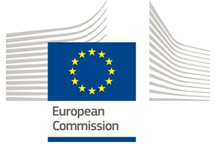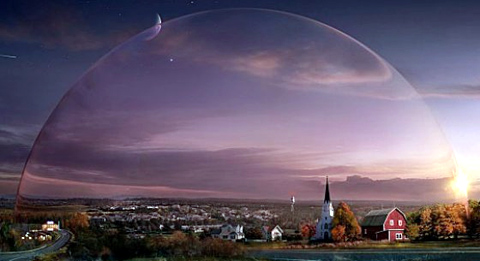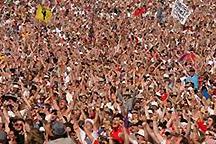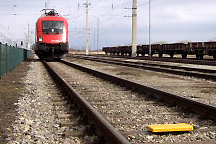 The European Commission has finally made a ruling on harmonising spectrum for programme making and special events (PMSE) use. PMSE includes things such as radiomicrophones and in-ear monitors that allow performers to hear themselves think whilst on a noisy stage.
The European Commission has finally made a ruling on harmonising spectrum for programme making and special events (PMSE) use. PMSE includes things such as radiomicrophones and in-ear monitors that allow performers to hear themselves think whilst on a noisy stage.You would think that the PMSE community would be cock-a-hoop about the fact that their needs had been recognised at a European level and that spectrum had been safeguarded for their specific use, but it appears that many in the industry believe it is too little. A spokesperson for the Association of Learned Engineers of Sound (Asso.LES) told Wireless Waffle:
All video and audio broadcasts use wireless devices in their production. The paltry and squalid spectrum being offered by the Commission will cause many thousands of creative, cultural and media industry workers to suffer harmful interference leading to infection and death. Add to this the many churches, schools and hotels who use wireless microphones and this ruling could cause a catastrophic failure of society. We could see plagues, widespread rioting and a failure of social cohesion resulting in a cataclysmic new world-order, not to mention the need to put up new antennas in some theatres.
No one from the Commission was available to comment, however Jörg Van Beaulieu who has a name that sounds like they could work for the Commission, was heard to comment:
Asso.LES couldn't see a gift horse if it kicked them in the face. The Commission has done its calculations and as far as we can see, the only events that will require more spectrum than we are offering are the Eurovision Song Contest and one or two occasions when sporting events occur on the same date as One Direction concerts - interruptions to which we believe the socio-economic impact would be low.
 The impact on the Eurovision Song Contest will come as a blow to its millions of fans both in Europe and across the world. Next year's organisers, ORF have already been in crisis discussions with the Austrian government and the European Commission and have issued this statement:
The impact on the Eurovision Song Contest will come as a blow to its millions of fans both in Europe and across the world. Next year's organisers, ORF have already been in crisis discussions with the Austrian government and the European Commission and have issued this statement:On advice of the Bundesministerium für Verkehr, Innvation und Technologie (BMVIT) we have decided to move the location of the competition next year from Vienna to Attnang-Puchheim. The town's railway marshalling yard will be flattened and a metal cage will be erected around the area to seal in the radio spectrum so it can be used for the Contest. We are sure that this will allow this critical European cultural event to go ahead without problems of interference from mobile phones or potentially dangerous inter-galactic laser beam weapons.

Meanwhile it is understood that the Council of Westminster are considering similarly drastic steps and that plans to demolish the majority of the West End to allow a protective metal dome to be built around London's infamous theatre district are well developed. The spokesperson for Asso.LES said that this move was welcome and rightly recognised the economic importance of radio microphone users above all other members of society.
add comment
( 689 views )
| permalink
| 



 ( 2.8 / 1655 )
( 2.8 / 1655 )




 ( 2.8 / 1655 )
( 2.8 / 1655 )
Sunday 31 August, 2014, 12:28 - Spectrum Management
Posted by Administrator
Yet another challenge to the seemingly overinflated forecast demand for IMT spectrum has been raised. This time, a paper entitled, 'Overestimating Wireless Demand: Policy and Investment Implications of Upward Bias in Mobile Data Forecasts' which has been written by Aalok Mehta of the University of Southern California and J. Armand Musey of Goldin Associates. Posted by Administrator
 Rather than do the maths on what their paper says, Wireless Waffle thought that it might be better to take a different approach and try and estimate how much spectrum may be needed in the far future, say in the year 2525. How much data could each person possibly consume? If it is assumed that each person lives in a totally immersive environment where there visual, audio and maybe even sensory experience is completely connected (a bit like a man-made version of The Matrix!) the question is how much data would this take?
Rather than do the maths on what their paper says, Wireless Waffle thought that it might be better to take a different approach and try and estimate how much spectrum may be needed in the far future, say in the year 2525. How much data could each person possibly consume? If it is assumed that each person lives in a totally immersive environment where there visual, audio and maybe even sensory experience is completely connected (a bit like a man-made version of The Matrix!) the question is how much data would this take? There are three things to consider:
- Firstly how much data is needed for such an immersive experience;
- Secondly, how much progress will have been made on the various audio and video codecs which squish the raw data into a more manageable form; and
- How spectrally efficient will the mobile technology be?
Video is currently the main bandwidth hog and whilst touch, feel and smell may turn out to be equally hungry for connectivity, let's focus on the video requirements first. If it is assumed that 3D video using ultra-high definition is required, today this would require a connection of 40 Mbps or faster. With improvements in coding technology, this could easily drop to 10 Mbps. If audio and other sensory data (including any personal machine-to-machine communications detecting, for example, heartbeat, ambient temperature and so on) doubles this, then a working assumption that a constant 20 Mbps of connectivity would allow a fully immersive experience would seem about right.
Finally we need to think about spectrum efficiency - how much spectrum would be needed to deliver this 20 Mbps. Current technologies such as LTE can deliver many bits per second per Hz of spectrum but performance becomes worse the futher away from the centre of a cell a user is. The ITU's model uses values of up to 5 bits per second per Hz in a 2020 timeframe, though other forecasts show values ranging from 2 to 15. By 2525, it ought to be possible to at least achieve the 5 bits per second per Hz value that the ITU forecasts is feasible by 2020, even as an average across a cell, and even those at the edge of coverage. This means that (whilst awake and living in the immersive environment) our mobile subscriber of 2525 would require around 4 MHz of spectrum dedicated to their sole usage.
How much spectrum is needed is therefore simply dictated by how many simultaneous users there are in each cell. Looking at this from a different direction, with around 1 GHz of mobile spectrum (not that different from the amount available today), 250 users could be supported in each cell. This seems perfectly realistic. Of course this amount of data would not be required by anyone who is asleep, and those at home or in an office could surely connect to the WiFi of the future and offload their data to an alternative service so 250 users per cell does not seem unreasonable.
So... even in a futuristic world in which everyone is immersed in a fully interactive environment for every waking hour, given developments in technology, 1000 MHz of spectrum dedicated to mobile networks seems sufficient. This result ties in with an interesting result posited by the Australian spectrum regulator ACMA in its report 'Towards 2020 - Future spectrum requirements for mobile broadband' (Figure 4.3) which indicates that spectrum demand may decrease in the future as the spectrum efficiency of newer technologies and improved coding techniques outpace the exponential growth in demand for data.
It therefore seems possible that we are going through a period in which spectrum demand for mobile broadband is at its peak as we phase out older mobile technologies and bring in the new and that in the long-term future, the amount of spectrum already available today will be enough to meet requirements. With this (albeit rather simplistic) analysis, we can now close the door on all the debate over spectrum for mobile services and instead focus on something more interesting...
Wednesday 9 July, 2014, 08:57 - Spectrum Management
Posted by Administrator
According to an article in DigitalSpy (and several other sources) UK mobile operator EE have announced that during the recent Glastonbury Festival, 0.74 TeraBytes (TB) of data was uploaded and 2.49 TB of data was downloaded (a total of 3.23 TB). EE built a special network at the site as part of its role as the sponsor. However it would be reasonable to assume that the other 3 mobile operators in the UK also carried traffic and despite them not having bespoke networks, designed to cover the event, let's give them the benefit of the doubt and assume that they carried as much traffic as EE. Thus, the total traffic from the event would be 12.9 TB.Posted by Administrator
It is interesting to compare this level of traffic with that which is predicted by the ITU spectrum demand forecast model that Wireless Waffle has discussed several times in the past. First some facts and figures about the festival:
- The 2014 Glastonbury festival ran from 25 - 29 June inclusive - 5 days in total.
- The area of the site is approximately 900 acres, which is 3.6 square km.
- Around 135,000 people attended the festival.
 We can therefore calculate some traffic figures and compare these to the ITU's forecasts. First of all, the easy one: 135,000 people in an area of 3.6 square kilometres equates to 37,500 people per square kilometre. The ITU's model shows up to 222,333 people per square kilometre in the densest (albeit urban) areas, but it would be hard to imagine an area more densely populated than that surrounding the festival, even in Central London.
We can therefore calculate some traffic figures and compare these to the ITU's forecasts. First of all, the easy one: 135,000 people in an area of 3.6 square kilometres equates to 37,500 people per square kilometre. The ITU's model shows up to 222,333 people per square kilometre in the densest (albeit urban) areas, but it would be hard to imagine an area more densely populated than that surrounding the festival, even in Central London. There was 12.9 TeraBytes of data traffic over the 5 day event, the equivalent of 78 TeraBytes per month if the same level of traffic was to continue over a whole month. This equates to 21.7 TB per month per square kilometre. For a densely populated (urban) area, the ITU's forecasts show 30 to 100 PetaBytes per month per square kilometre, 1,400 to 4,700 times more than was consumed by revellers at Glastonbury.
Finally, if 78 TB of data was generated by 135 000 people, this equates to 578 MegaBytes per person per month. Compare this with the 212 GigaBytes per person per month preducted by the ITU, and we find a that the ITU's values are 366 times larger.
 So the ITU's traffic forecasts for 2020 show traffic density over 1,500 times greater than that which was generated at Glastonbury, with individual (per person) traffic that is 366 times larger. Even given the likely growth in data between 2014 and 2020 (which the ITU's highest forecasts indicate a growth of a factor of 14 times), the ITU's figures remain far in excess of any reality - at least any reality that exists on planet Earth. Just what the value of a set of forecasts that might be valid on Kepler 22b is, is anyone's guess. Perhaps that's where the ITU spends its summer vacation?
So the ITU's traffic forecasts for 2020 show traffic density over 1,500 times greater than that which was generated at Glastonbury, with individual (per person) traffic that is 366 times larger. Even given the likely growth in data between 2014 and 2020 (which the ITU's highest forecasts indicate a growth of a factor of 14 times), the ITU's figures remain far in excess of any reality - at least any reality that exists on planet Earth. Just what the value of a set of forecasts that might be valid on Kepler 22b is, is anyone's guess. Perhaps that's where the ITU spends its summer vacation?Wednesday 11 June, 2014, 09:00 - Spectrum Management
Posted by Administrator
You would have thought that those designing systems that use the radio spectrum would check that the frequencies they planned to use would not cause interference to other systems and equally importantly that they would not suffer interference from other users. Such basic compatibility checks are critical to ensure that different communication systems can inter-operate successfully. So it is a bit of a surprise to find that the designers of the Eurobalise, a technology that forms part of the European Rail Traffic Management System and whose purpose is to assist in the control of train movements (to control their movement and help them know where they are) has chosen a frequency which fails these simple safeguards.Posted by Administrator

Where they have gone wrong is to use a frequency for transferring information between the Eurobalise and the train that is in a European broadcast band!
 The Eurobalise uplink operates on a centre frequency of 4234 kHz, with a frequency deviation of +/- 282 kHz. This means that a logic '1' is sent on a frequency of 4516 kHz and a logic '0' is sent on a frequency of 3952 kHz (source: Mermec Eurobalise specification). Interfering signals on, or near, frequencies of 3952 or 4516 kHz would cause the most trouble, but as the Balise's receiver is listening across the whole range 3952 to 4516 kHz, any transmission in this range would cause a problem. The (European) 75 metre broadcast band runs from 3950 to 4000 kHz. Any broadcasts in the 75 meter band could therefore cause a problem to nearby trains, but those on frequencies from approximately 3950 to 3955 kHz will have the greatest potential to interfere with the Balise's operation.
The Eurobalise uplink operates on a centre frequency of 4234 kHz, with a frequency deviation of +/- 282 kHz. This means that a logic '1' is sent on a frequency of 4516 kHz and a logic '0' is sent on a frequency of 3952 kHz (source: Mermec Eurobalise specification). Interfering signals on, or near, frequencies of 3952 or 4516 kHz would cause the most trouble, but as the Balise's receiver is listening across the whole range 3952 to 4516 kHz, any transmission in this range would cause a problem. The (European) 75 metre broadcast band runs from 3950 to 4000 kHz. Any broadcasts in the 75 meter band could therefore cause a problem to nearby trains, but those on frequencies from approximately 3950 to 3955 kHz will have the greatest potential to interfere with the Balise's operation. Do any such transmissions exist? According to short-wave.info, the BBC and Korean broadcaster KBC use a frequency of 3955 kHz on a daily basis, from the BBC's transmitter at Woofferton, Shropshire. If you click on the link (which will take you to Google maps) you will notice that running alongside the village of Woofferton is a grey line - a railway!
But surely fears of interference are unfounded and just another example of scare tactics by spectrum managers bent on safeguarding their highly paid jobs. Sadly not... It appears that the transmissions from Woofferton have been disrupting trains between Leominster and Ludlow! According to the article in the Hereford Times, Network Rail, the organisation responsible for operating the rail infrastructure in the UK, claim:
while the interference does not pose a risk to the safe operation of the railway, it has been stopping trains en-route.
Oops!
 The only other high power transmitter in this band in Europe is at Issoudun in central France. A quick check of Google maps shows that there are no train tracks in the immediate vicinity. There is a transmitter in Kall-Krekel in north west Germany which also uses frequencies in the 75 metre broadcasting band that could also cause interference to Eurobalises, but that transmitter uses much lower power than those at Woofferton or Issoudun.
The only other high power transmitter in this band in Europe is at Issoudun in central France. A quick check of Google maps shows that there are no train tracks in the immediate vicinity. There is a transmitter in Kall-Krekel in north west Germany which also uses frequencies in the 75 metre broadcasting band that could also cause interference to Eurobalises, but that transmitter uses much lower power than those at Woofferton or Issoudun.Maybe, given that there is only one potential location where the choice of frequency, and proximity to a broadcast transmitter, could be a problem, the designers did do their homework after all and decided that it was alright for occasional problems to arise. Maybe. Then again, the other frequencies used by the Eurobalise include a military band and the middle of the 27 MHz Citizens Band!

